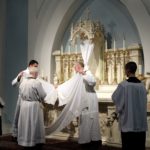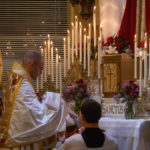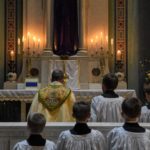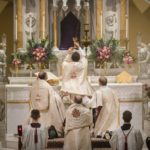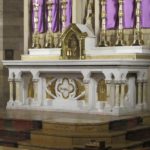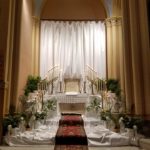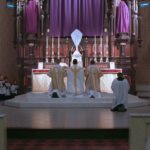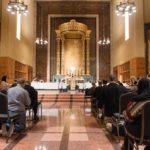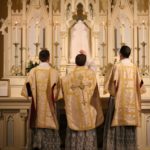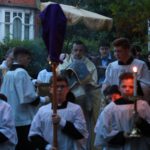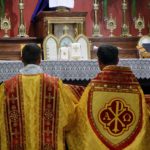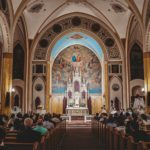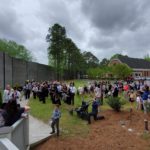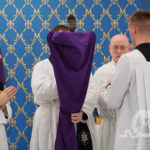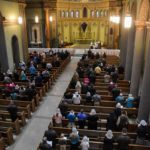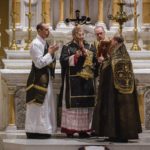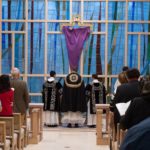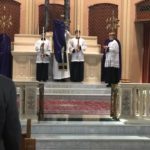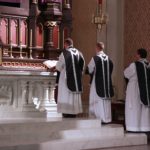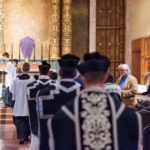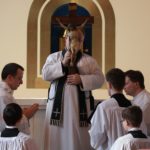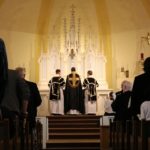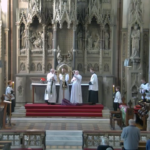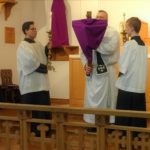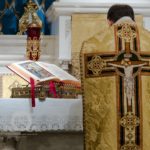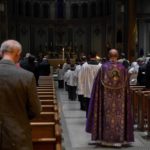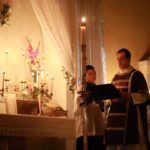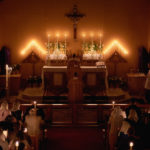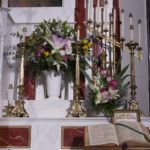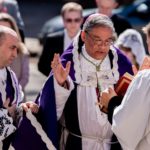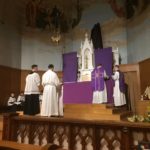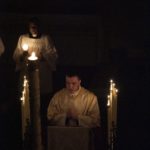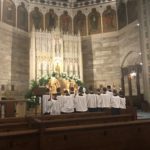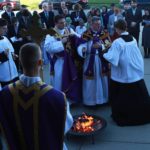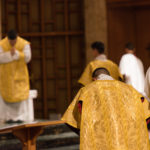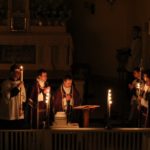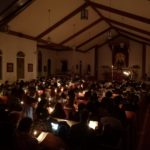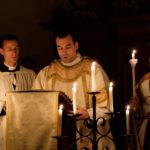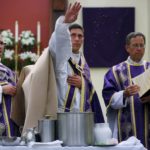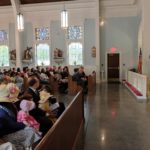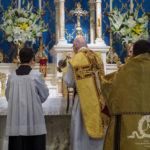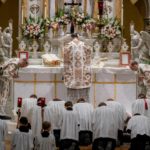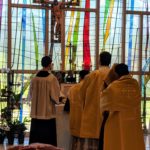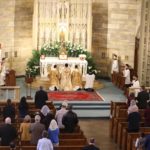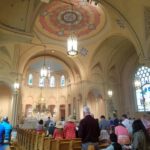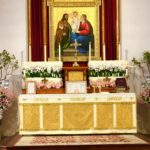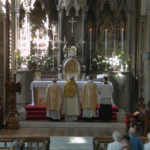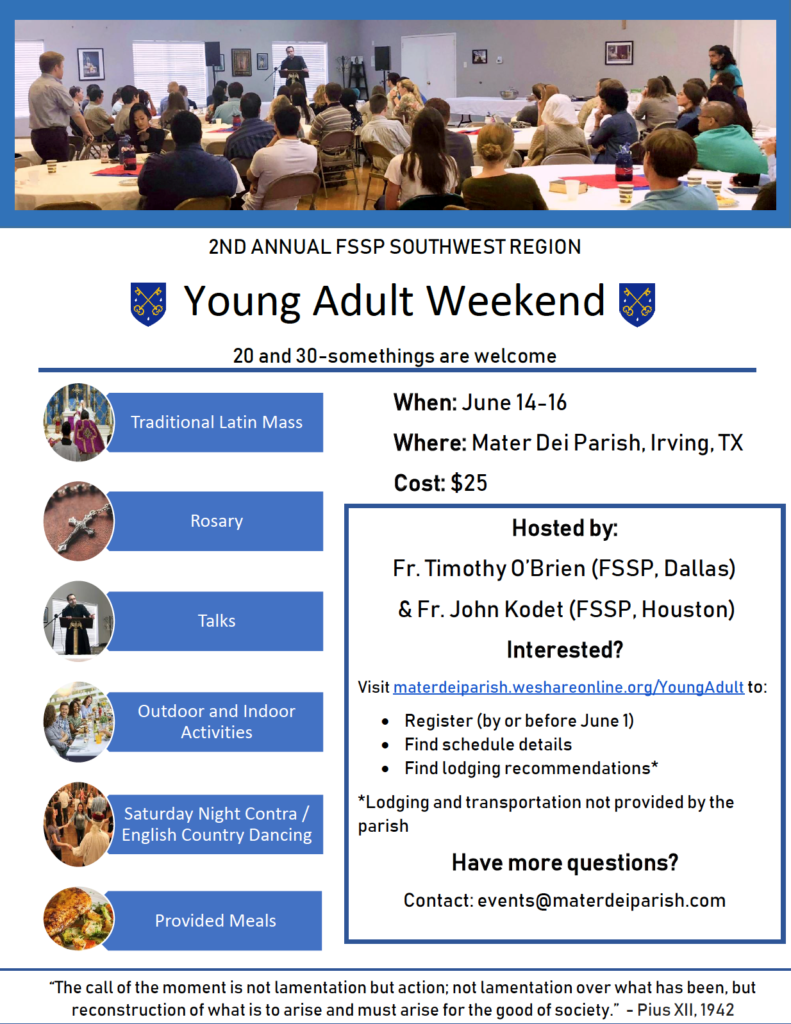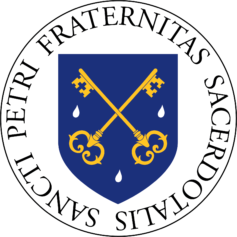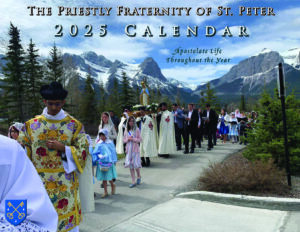Happy Mother’s Day!
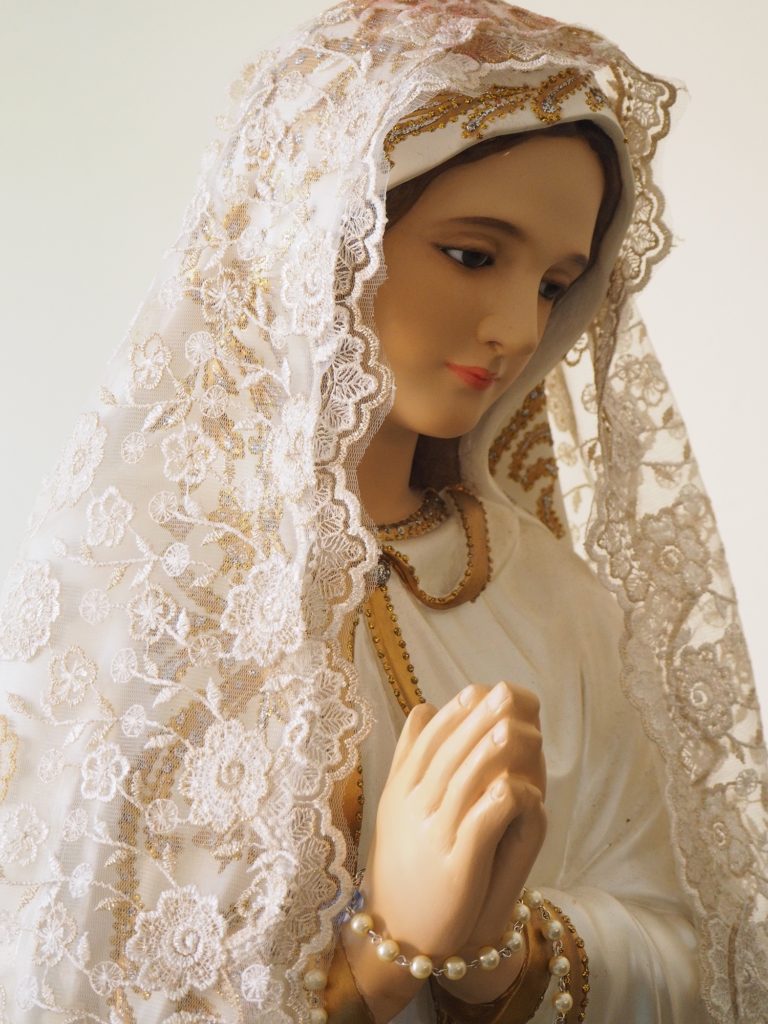
A happy and most blessed Mother’s Day to all mothers! Let us take time today to thank God for the natural, adopted and spiritual mothers in our lives, for their love towards us and for the sacrifices they have made for us. For so many of us, our mothers were the first to teach us the Faith and to instill the love of God in us, and so today we give thanks for both the physical and spiritual care they gave us. This day on which we honor our earthly mothers providentially falls in the month of May dedicated to Our Lady, who is the Mother of Christ and of us, the members of His Mystical Body.
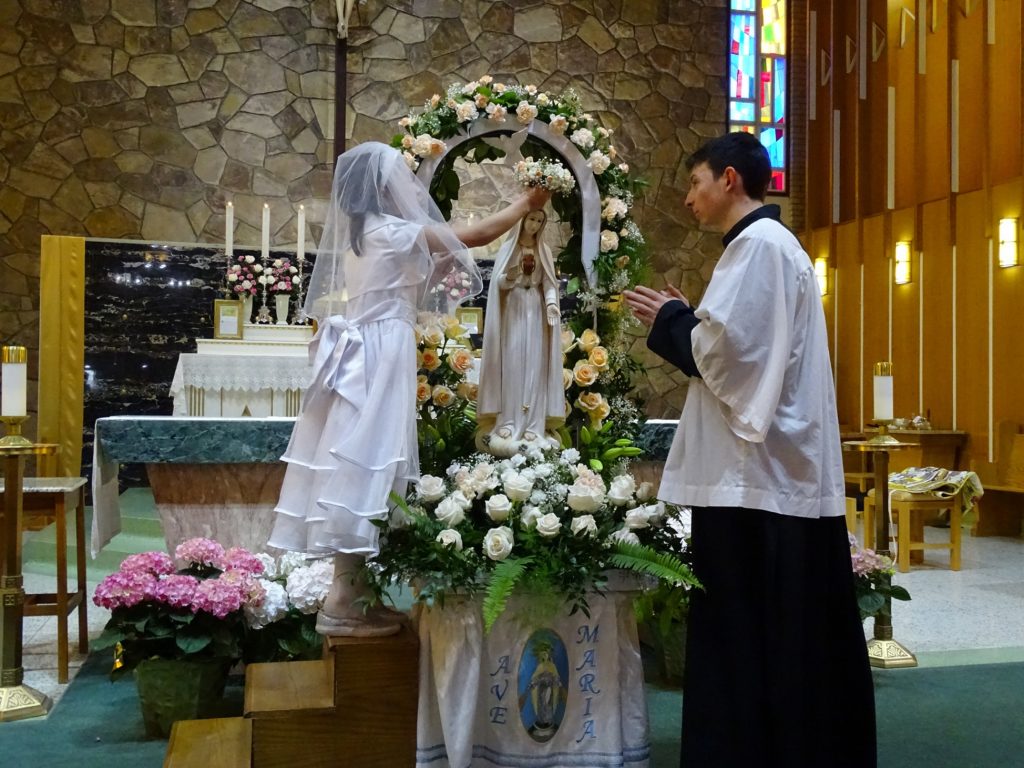
One of the most enduring Marian traditions during this time is that of the May crowning, where children of the parish carry flowers to Our Lady and adorn her statue with a crown or a wreath of flowers to honor her as “Queen of the Angels, Queen of the May”, as a beloved old hymn goes. Some of our parishes celebrated the Crowning last Sunday, some today, and certainly this beautiful tradition is a most fitting way to honor our Blessed Mother around the time of Mother’s Day.
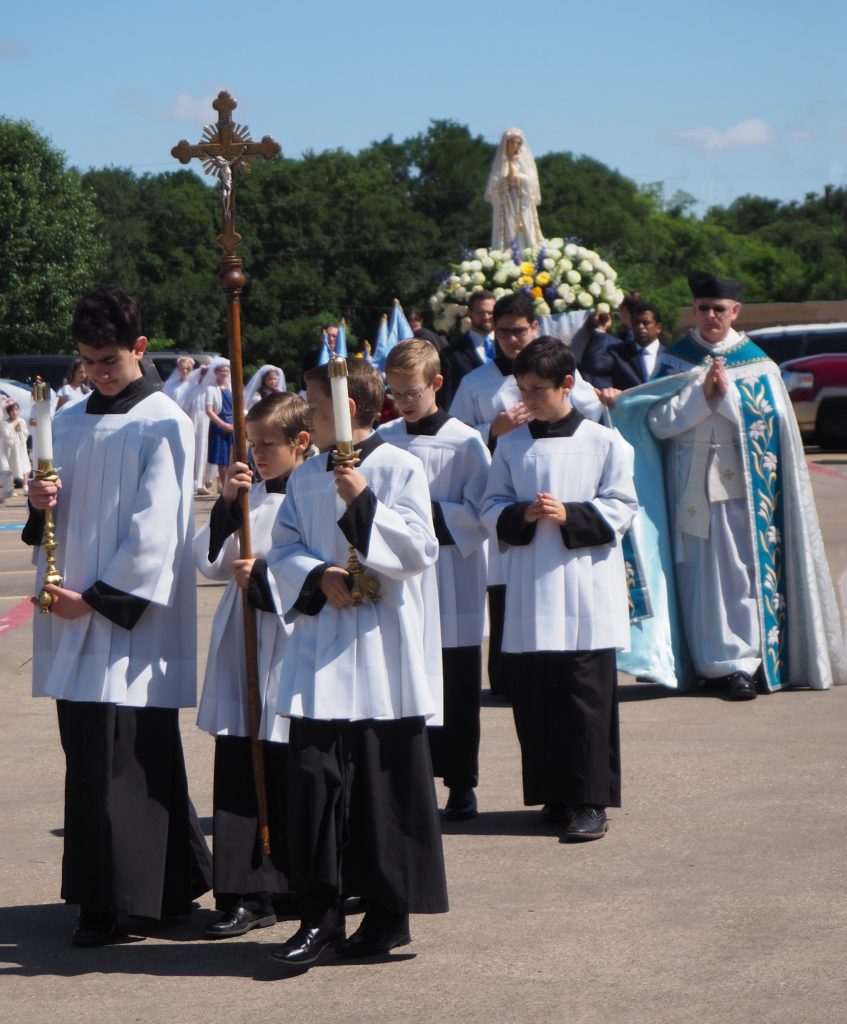
And so, let us pray for our mothers today, let us honor them and entrust them to the care of Our Lady, the Queen and model of all mothers. Let us also entrust ourselves to the care of this dear Mother, and approach her daily with the same trust and love as the children who crown her with blossoms in May. +
Ego quasi vitis fructificávi suavitátem odóris: et flores mei, fructus honóris et honestátis. Ego mater pulchræ dilectiónis, et timóris, et agnitiónis, et sanctæ spei.
As the vine I have brought forth a pleasant odor, and my flowers are the fruit of honor and riches. I am the mother of fair love, and of fear, and of knowledge, and of holy hope.
Ecclesiasticus 24:17-18
May 12, 2019

The Sacred Triduum Across the District
From Thursday, April 18th, through Sunday, April 21st, the Church celebrated the holiest days of the liturgical year. Here we bring you the celebrations of the Sacred Triduum, as it was commemorated by our apostolates in the United States, Canada and beyond. Click on a picture to see where it is from, or, if you are up for a challenge, try to name the apostolate without looking at the caption! We hope your own Triduum was fruitful and blessed. +
Holy Thursday
Good Friday
Easter Vigil
Easter Sunday
May 9, 2019

Camp St. Isaac Jogues: Deadline Extended!
 If you missed the deadline for our annual boys’ camp in Elmhurst, Pennsylvania, you’ve got another chance to sign up! The deadline has been extended to Friday, May 24th. The camp, run by priests and seminarians from the Priestly Fraternity of St. Peter, is scheduled for July 15th – 25th, 2019 and is open to boys ages 13 – 15. Visit the camp’s website here for more information and to download the signup form.
If you missed the deadline for our annual boys’ camp in Elmhurst, Pennsylvania, you’ve got another chance to sign up! The deadline has been extended to Friday, May 24th. The camp, run by priests and seminarians from the Priestly Fraternity of St. Peter, is scheduled for July 15th – 25th, 2019 and is open to boys ages 13 – 15. Visit the camp’s website here for more information and to download the signup form.
You can keep up with all our camps and events by bookmarking our events page: www.fssp.com/events.
May 8, 2019

Sign Up for FSSP Southwest Region Young Adult Weekend
Last June, Mater Dei Parish, our apostolate in Dallas, Texas, sponsored a hugely successful young adults’ weekend. Over 90 young men and women attended the event that we covered at the Missive (read the post here), and we said to stay tuned for information about future events. Well, summer is on the horizon in 2019 and true to our word, we bring you the 2nd Annual FSSP Southwest Region Young Adult Weekend, scheduled for the weekend of June 14th!
The conference includes the traditional Latin Mass, the Rosary, talks on Catholic culture, recreational activities and a Saturday evening contra dance. Single young adults in their 20s and 30s are welcome and the cost is a mere $25, which includes meals. See the flyer below for more information and register here by June 1st!
May 6, 2019

Priestly Ordinations: May 24th, 2019
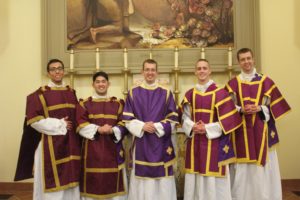 We ask your prayers for the five deacons of the Priestly Fraternity of St. Peter who will be ordained to the sacred priesthood this month. Four will be ordained in Lincoln, NE by the Most Reverend Fabian Bruskewitz, Bishop Emeritus of the Diocese of Lincoln, Nebraska, and one in Ottawa, Ontario, Canada by the Most Reverend Terrence Prendergast, Archbishop of Ottawa. All are welcome to attend, and the Lincoln ordinations will also be broadcast live on LiveMass.
We ask your prayers for the five deacons of the Priestly Fraternity of St. Peter who will be ordained to the sacred priesthood this month. Four will be ordained in Lincoln, NE by the Most Reverend Fabian Bruskewitz, Bishop Emeritus of the Diocese of Lincoln, Nebraska, and one in Ottawa, Ontario, Canada by the Most Reverend Terrence Prendergast, Archbishop of Ottawa. All are welcome to attend, and the Lincoln ordinations will also be broadcast live on LiveMass.
Rev. Mr. John Killackey, FSSP
Wayne, New Jersey, USA
Rev. Mr. Ralph Oballo, FSSP
Calgary, Alberta, Canada
Rev. Mr. Daniel Powers, FSSP
Orland Hills, Illinois, USA
Rev. Mr. Jesus Valenzuela, FSSP
El Paso, Texas, USA
will be ordained on Friday, May 24th, 2019 at 10 a.m. at St. Thomas Aquinas Catholic Church, 320 N. 16th St., Lincoln, NE 68508.
Rev. Mr. Luc Poirier, FSSP of Irishtown, New Brunswick, Canada will be ordained on Friday, May 31st, 2019 at 7 p.m. at Notre Dame Cathedral Basilica, 56 Guigues Avenue, Ottawa, ON K1N 5H5.
Please keep in prayer also the two German and four French deacons from our Wigratzbad seminary who will be ordained on June 29th in Heimenkirch, Germany by the Most Reverend Czesław Kozon, Bishop of Copenhagen. +
May 2, 2019

Święconka
What is święconka, you ask? You may actually know already. Perhaps your parish celebrates this Polish tradition – many of our apostolates do, such as Holy Cross Chaplaincy in Fresno, CA, St. Benedict in Chesapeake, VA and St. Mary in Philadelphia, PA (a parish with strong Polish roots), just to name a few. Since the Middle Ages in Poland, families have brought carefully prepared and decorated baskets of Easter victuals to be blessed at the church on Holy Saturday. A traditional basket might be created by lining it with fine cloth or lace, filling it with foodstuffs such as eggs, bread, bacon and sweets, covering it all in linen and decorating it with sprigs of boxwood, or bukszpan, the Easter evergreen. Everything in the basket has a particular meaning relating to the Passion and Resurrection of Our Lord. Here’s just a few of the treats and their symbolism:
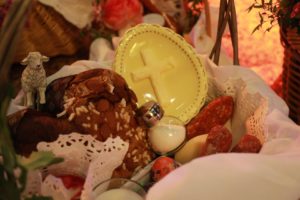
Eggs – new life and Christ’s Resurrection
Horseradish – the bitterness of Christ’s Passion
Easter Bread (babka) – a traditional bread symbolizing the risen Christ
Lamb – signifies the Paschal Lamb and is usually made from the same yeast cake as babka
Bacon – the superabundance of God’s goodness (validation for all the bacon-lovers out there)
Sweets – Heaven and the good things to come
Salt – immortality
Many other things might be included, such as butter, symbolizing the richness of our salvation and the end of Lent, and kiełbasa links that illustrate the chains of death broken by Christ. The linen covering itself represents the shroud of Christ.
Of course, no one is more knowledgeable about a country’s traditions than a bona fide native. Fr. Andrzej Komorowski, Superior General of the Priestly Fraternity of St. Peter, hails from Poland, and he told us a bit about how the święconka tradition is celebrated in his home country.
“In many families there would be children (with the parents/grandparents) who go and bring the basket,” he said. “It is also an occasion to visit and pray at the tomb of Christ (the Blessed Sacrament is transferred to the tomb for adoration on Good Friday).”
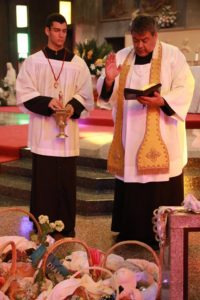
Though the baskets are blessed on Holy Saturday, they must of course remain untouched until Easter.
“This blessed food will be used at the Easter Sunday breakfast which will start after the morning Mass,” said Fr. Komorowski. “We start the breakfast with wishes and sharing of this blessed food.”
A mighty penance indeed to see all the wonderful goodies but to remain disciplined until Easter morning! The longing itself typifies the great anticipation we feel during the final hours of the Triduum as we await Christ’s glorious Resurrection and the promise of new life that He brings. On Easter morning, the shroud is laid aside and we partake with joy in the blessings of the risen Christ. We certainly hope that your Easter is overflowing with the blessings of God, so richly symbolized by this enduring tradition. Happy Easter, or as they say in Poland, Wesołych Świąt Wielkanocnych! +
April 30, 2019

Sacred Liturgy Conference
May 28th – 31st, 2019
From May 28th – 31st, 2019 in Spokane, WA, Schola Cantus Angelorum will host their annual Sacred Liturgy Conference, an event  that strives to educate the faithful about the realities of the Mass, to encourage dignity and beauty in its celebration and to promote the use of sacred music. Featured speakers at this year’s conference include Archbishop Salvatore Cordileone of San Francisco, Dr. Nathan Schmiedicke, professor of Sacred Scripture at Our Lady of Guadalupe Seminary, ICEL director Msgr. Andrew Wadsworth and many more. A particularly special guest this year is His Eminence Joseph Cardinal Zen, who will speak via pre-recorded interview about the Gregorian liturgy in China.
that strives to educate the faithful about the realities of the Mass, to encourage dignity and beauty in its celebration and to promote the use of sacred music. Featured speakers at this year’s conference include Archbishop Salvatore Cordileone of San Francisco, Dr. Nathan Schmiedicke, professor of Sacred Scripture at Our Lady of Guadalupe Seminary, ICEL director Msgr. Andrew Wadsworth and many more. A particularly special guest this year is His Eminence Joseph Cardinal Zen, who will speak via pre-recorded interview about the Gregorian liturgy in China.

The FSSP has been involved with the conference since 2016, former FSSP District Superior Fr. Gerard Saguto appearing as a featured speaker in past years. The FSSP will again lend its assistance this year.
“The Sacred Liturgy Conference has been very blessed with the competent assistance of the FSSP priests since 2016,” said Dr. Lynne Bissonnette-Pitre, executive director of the Conference. “Fr. Heffernan, Fr. Passo and Fr. Gerard Saguto have been invaluable to the conferences by serving at the altar in our Extraordinary Form Masses, especially the Pontifical High Masses in 2016 with Archbishop Alexander Sample, in 2017 with Cardinal Raymond Burke and in 2018 with Bishop Athanasius Schneider. In addition, Fr. Gerard Saguto served on the faculty in 2017 and 2018 and gave outstanding and highly favored lectures. We are very, very grateful for the support and the expertise of the FSSP.”
As well as the selection of twelve lectures, the conference will also feature Gregorian Chant and Extraordinary Form workshops and four Masses, including a Pontifical High Mass for the Ascension and a Solemn High Dominican Rite Mass for the Queenship of Mary. The lectures and workshops will take place at the Hemmingson Center on the campus of Gonzaga University, and the Masses will take place nearby at St. Aloysius Church and the Cathedral of Our Lady of Lourdes.
For more information on the schedule and to register, visit the conference’s website at www.sacredliturgyconference.org.
April 26, 2019

Sign Up for the Albertus Magnus Summer Program
Traditional theology and traditional liturgy in the land of saints, sunshine and coffee
The St. Albert the Great Center for Scholastic Studies will hold its 8th annual summer theology session in Nursia, Italy (birthplace of Ss. Benedict and Scholastica), in partnership with the Benedictine Monks of Nursia, who are famous for their beautiful Gregorian chant and Birra Nursia. This summer’s program will be focused on St. Thomas Aquinas’ commentary on the first eight chapters of John’s Gospel.
Program combines in-depth study of Scripture and theology, beautiful sacred liturgy (daily Traditional Latin Mass and Divine Office) and delightful Italian cuisine.
Dates: June 16th – 28th, 2019
Cost: €1550
Application deadline (approaching soon!): May 1st, 2019
Full details and application form at: https://www.albertusmagnuscss.org/summer-programs/2019-italy/
April 23, 2019

Christus Resurréxit! Resurréxit Vere!
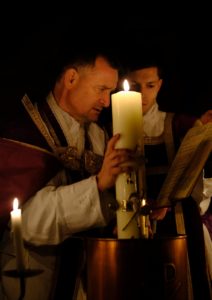
Christ is risen, alleluia! Indeed, He is risen, alleluia! A happy and most blessed Easter to you and your families! May the abundant blessings of God be upon you as we celebrate this most glorious feast and enter into the joyful time of Paschaltide, celebrating Christ’s great triumph over sin and death and the new life that He won for us.
The first Mass of Easter is the beautiful Vigil Mass, one of the most stunning ceremonies of the liturgical year. The ceremony begins outdoors the night of Holy Saturday with the kindling and blessing of the New Fire and the blessing of the Paschal Candle, which is lit from the Fire and in turn lights the candles carried by the ministers and people during the liturgy. The priest and people process into the church, led by the lit Paschal Candle, the symbol of the Risen Christ, and the liturgy continues with readings from the Old Testament that describe the history of God’s plan of salvation. Afterwards are blessed the baptismal waters that will be used in the coming year, and those present renew the promises of their Baptism. When all is complete, the Solemn Mass of the Vigil is offered and concludes with the Solemn Lauds of Easter Day. +
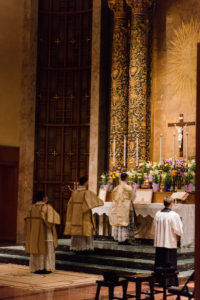
Let the angelic choirs of Heaven now rejoice; let the divine mysteries rejoice; and let the trumpet of salvation sound forth the victory of so great a King. Let the earth also rejoice, made radiant by such splendor; and, enlightened with the brightness of the eternal King, let it know that the darkness of the whole world is scattered.
– from the Exsultet, the beautiful proclamation of Easter sung by the deacon
The Masses and devotions of the Triduum can be viewed at our online apostolate, LiveMass.
April 21, 2019

Good Friday
Today is the most somber and sorrowful day of the year. On this day we commemorate the sacrifice of Our Lord of His own life for our redemption and the unfathomable suffering, infinitely beyond any human trial, which He endured for us sinners. The Church in her sorrow fasts and abstains and maintains a spirit of the deepest solemnity.
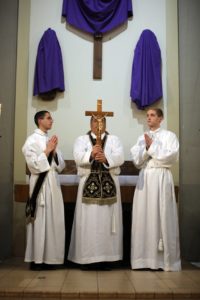
No Mass is celebrated. The liturgy comprises readings from the Old Testament and the reading of St. John’s Passion, the praying of the Great Intercessions, the Adoration of the Cross, and the reception of the Holy Eucharist, reserved from the Mass of Holy Thursday. In some places the ceremonies of today are called the Mass of the Presanctified, the term “presanctified” signifying that the Sacrament was consecrated at an earlier time. The vestments worn are black, the color used by the Church for times of mourning.
After this Jesus, knowing that all was now finished, said (to fulfill the scripture), “I thirst.” A bowl full of vinegar stood there; so they put a sponge full of the vinegar on hyssop and held it to His mouth. When Jesus had received the vinegar, He said, “It is finished”; and He bowed His head and gave up His spirit.
– John 19:28-30
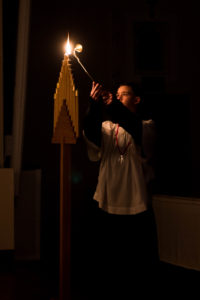
One of the most interesting aspects of the devotions of the Triduum is the office of Tenebræ, the combined celebration of the offices of Matins and Lauds in the early mornings of Holy Thursday, Good Friday and Holy Saturday. The office is stark and simplified, lacking any of the aspects of joy normally contained in these Hours, such as the Gloria Patri, and including readings from the soul-rending Lamentations of Jeremiah. The office is sung in darkness (tenebræ is Latin for “darkness” or “shadows”), by the light of six altar candles and fifteen candles mounted on a triangular candlestick known as a “Tenebræ hearse”. The hearse candles are extinguished one by one as the psalms are completed until the topmost candle only is lit, and the six altar candles too are extinguished. The last remaining candle is then hidden behind the altar or a curtain, leaving the church in total darkness and symbolizing the hiding of the Light of the World when He died and was buried. Those present make noise by banging books or knocking on pews or choir stalls, illustrating the consternation of nature at the death of its God. The candle reappears and the noise ceases, just as Christ completed His work of restoring order to Creation by reappearing on Easter Sunday.
The Church, then, keeps company with Our Lady in the solemn silence that followed the death of Christ, looking in faith and hope for the new dawn soon to come. +
The Masses and devotions of the Triduum can be viewed live at our online apostolate, LiveMass.
April 19, 2019


